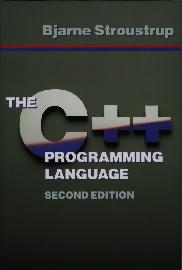The C++ Programming Language (Second Edition)
Addison-Wesley, ISBN 0-201-53992-6.


Highlights:
Here are my first impressions.
The ideal textbook for new C++ programmers would be: (1) must be ``reference quality'' wrt the language proper. (2) should explain how to use the language as a tool.
In other words, it should both say what the language *is*, as well as *how* to use it (new programmers seem to find the language's ``dark corners more quickly than can be imagined, so a reference quality text is absolutely essential).
Bjarne's new book is this ideal.
Bjarne's book does something that none of the other C++ textbooks have succeeded up to now: he integrates a tutorial on the *use* of the language along with the gnarley details of exactly what is legal. If that was where he stopped, I for one would've been thrilled (I've often commented to my classes that I'm waiting for such a book).
But he didn't stop there. Not only does it cover proper use along with a language reference manual, it also covers the rudiments of integrating object oriented *design*. There are some elided aspects of the OOD treatment (see below for details), but I'll concentrate on what it *does* cover, and I'll say that the software engineering aspects of the text are at a level that was previously available only in strictly OOD books, such as Booch's excellent text (or Wirfs-Brock et al or Rumbaugh et al, etc).
The general approach (language first, then design) is one that I personally find easy to teach from. Some will argue with me on this point, but both my learning and teaching experience has taught me that people learn first concrete, *then* abstract. ``One apple and two apples make three apples'' is mastered long before ``x + 2x = 3x''. Thus people learn new material by relating it to things they already understand, a belief that seems to be well accepted in educational circles, especially with regard to computers (cite [R. Mayer, The Psychology of How Novices Learn Computer Programming, Comp Surveys, 13 (1981), 121-41], [D. Ausubel, The use of advance organizers in the learning and retention of meaningful verbal material, J. Educ Psychol, 51 (1960), 266-74], etc).
This philosophy, if accepted, has numerous pragmatic impacts on the curriculum. For example, I teach multiple polymorphism only after the student has a firm grasp on single polymorphism (I *could* start with the ``most general case'' and worked toward simpler concepts). Again, virtual dispatching isn't covered until I thoroughly establish the basic concepts of encapsulation, classes and objects.
These decisions fit the ``Just In Time'' approach to education: don't teach an abstract (and hence powerful) concept until the student is ready to tackle problems that *require* the extra power. The abstract concepts are provided ``just in time.'' The student is thereby provided with a built-in motivation, and never has to ask, ``Why am I bothering to learn this?''
On the down side, it usually results in a spiral curriculum, so it would be faster to go directly for the most general case. Educators often complain of the long learning curve to master the paradigm + language. The need for people to ``decompress'' in the new paradigm is inevitable, but I've found it can be accelerated by the ``just in time'' approach (ex: it gives people a concrete formalism within which to express their thoughts).
Bjarne's book uses this ``just in time'' approach effectively.
FINAL THOUGHTS:
The book is excellent. Every C++ programmer should have a copy.
-- Marshall Cline